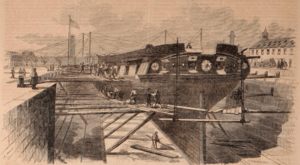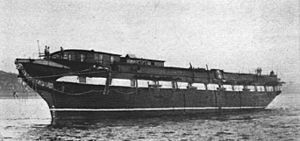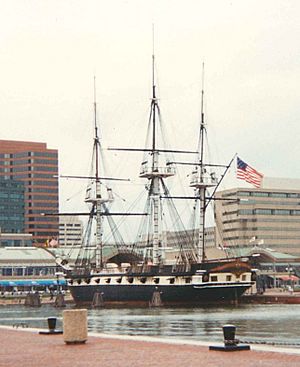USS Constellation (1854) facts for kids
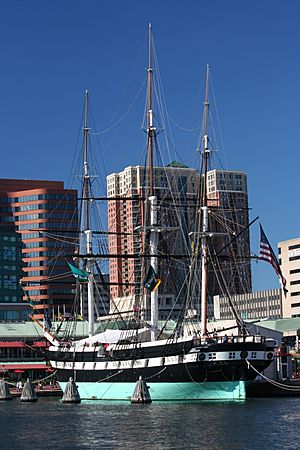
Constellation at Baltimore's Inner Harbor
|
|
| History | |
|---|---|
| Builder | Norfolk Naval Shipyard |
| Laid down | 25 June 1853 |
| Launched | 26 August 1854 |
| Commissioned | 28 July 1855 |
| Renamed | Old Constellation, 1 December 1917 |
| Renamed | Constellation, 24 July 1926 |
| Decommissioned | 16 June 1933 |
| Recommissioned | 24 August 1940 |
| Reclassified | Miscellaneous Unclassified (IX-20), 8 January 1941 |
| Decommissioned | 4 February 1955 |
| Stricken | 15 August 1955 |
| Status | Museum ship |
| General characteristics | |
| Type | Sloop-of-war |
| Displacement | 1,400 long tons (1,400 t) |
| Length |
|
| Beam |
|
| Draft | 21 ft (6.4 m) |
| Propulsion | Sail |
| Complement |
|
| Armament |
|
|
USS Constellation (Frigate)
|
|
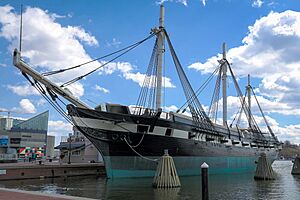 |
|
| Location | Baltimore, Maryland |
| NRHP reference No. | 66000918 |
| Significant dates | |
| Added to NRHP | 15 October 1966 |
| Designated NHL | 23 May 1963 |
The USS Constellation is a famous sloop-of-war. This means she was a warship powered only by sails. She was the last ship of her kind built for the United States Navy. Workers built her at the Gosport Shipyard between 1853 and 1855.
The ship got her name from an older frigate called USS Constellation. That older ship was taken apart in 1853. The new Constellation carried powerful guns. These included sixteen 8-inch shell-firing guns and four 32-pounder long guns. She also had other guns, like two Parrott rifles.
The Constellation's time as a main warship was short. She served in the Mediterranean Sea from 1855 to 1858. In 1859, she became the lead ship for the Africa Squadron. There, she helped stop the slave trade. During the American Civil War (1861–1865), she went back to the Mediterranean. Her job was to look for Confederate ships. In late 1864, she returned to the United States. Most of her crew's time was up, so she was taken out of service. She stayed out of action for the rest of the war.
In 1871, the Constellation was put back into service. She became a training ship for young naval officers called midshipmen. She was used for shooting practice and training trips for 22 years. During this time, she did many other things. For example, she carried exhibits for a big show in Paris in 1878. She also took food to Ireland during a famine in 1879. By late 1893, she became a stationary training ship. She stayed docked in Newport for the next 20 years.
During this period, people started to believe that the two Constellation ships were the same. In 1914, she was shown as the original ship. This was during the 100-year celebration of "The Star-Spangled Banner". In 1917, her name was briefly changed to Old Constellation. This was to make the name available for a new battlecruiser. But the battlecruiser was scrapped in 1925, so the ship got her original name back. The Constellation was put back into service in 1940. This was part of the preparations for the United States joining World War II. During the war, she served as the main ship for the commander of the Atlantic Fleet.
People wanted to turn the ship into a museum ship in the 1930s. But real work began after World War II. It took until 1955 to get enough money to move her to Baltimore, Maryland. People still thought she was the original Constellation. So, during a big repair job in the late 1950s and early 1960s, they changed her to look like the older ship. This led to a big debate about her true identity. This debate lasted until the 1990s. New research finally proved that the ship launched in 1797 and the one launched in 1854 were different ships.
Since the mid-1990s, the ship has had regular repairs to fix rotting wood. Today, the Constellation is open to visitors. She is part of the Historic Ships in Baltimore in the city's Inner Harbor. She is also a National Historic Landmark.
Contents
Building the Ship
From 1816 to the 1830s, the Navy collected a lot of live oak wood. This wood was for building new warships. In the early 1850s, the Navy decided to build a new sail-powered ship. They wanted a fast sloop-of-war that could travel far. It also needed to be armed well enough to fight other warships of its type.
Building this way kept costs low. The wood was already on hand, and they didn't need an expensive steam engine. John Lenthall, the Chief Constructor, designed the ship. Edward Delano, from the Gosport Shipyard, also helped. In June 1853, Lenthall finished the hull design. This was needed to plan the ship's size and prepare the wood. At this time, the older USS Constellation was being taken apart nearby.
Work on the new ship began in May 1853. Shipyard workers started putting the wood together. The ship's keel (the backbone) was laid down on June 25, 1853. They used wood from the oak supply. Her sternpost (back part) was put up on August 27. Her stem (front part) followed a few weeks later. She was launched into the water on August 26, 1854, at 11:45 AM. After launching, workers installed her masts, ropes, and guns. This process is called fitting-out.
Ship's Details
The Constellation is 181 feet long at the waterline. She is 199 feet long overall. Her width is 41 feet at the waterline. At her widest point, she is 43 feet across. Her deepest part, called the draft, is 21 feet. When fully loaded, she weighs about 1,400 tons. The ship's crew included 21 officers and 265 sailors.
When first built, the Constellation had many guns. She had sixteen 8-inch shell-firing guns. She also had four 32-pounder guns on her gun deck. On her top deck, called the spar deck, she carried two chase guns. A 30-pounder Parrott rifle was at the front. A 20-pounder Parrott rifle was at the back. She also carried three 12-pounder boat howitzers.
Life at Sea
The Constellation officially started service on July 28, 1855. Captain Charles H. Bell was her first commander. She immediately went on a three-year trip with the Mediterranean Squadron. In July 1856, she stopped in Málaga, Spain. Her job was to protect American citizens during a time of unrest. Later that year, she helped a ship in the Sea of Marmara. The Emperor of Austria officially thanked her for this help.
On April 17, 1858, she left the Mediterranean. She went to the Caribbean Sea to protect American ships. On June 5, she returned to the New York Navy Yard. Then she went to Boston, where she was taken out of service on August 13.
In June 1859, she was put back into service. She joined the Africa Squadron as its main ship. Captain Thomas Aloysius Dornin was her commander. She arrived near the Congo River on November 21. There, she began working to stop the Atlantic slave trade. The Navy gave money for each slave ship captured. They also gave $25 for each freed slave. This money was shared among the crew.
On December 29, she captured a ship called Delicia. It had no papers and was set up to carry slaves. On September 26, 1860, the Constellation captured another ship, the Cora. This ship had 705 slaves on board. They were freed in Monrovia, Liberia. The Navy took Cora and sold her.
Civil War Service
A week after the Battle of Fort Sumter, which started the American Civil War, President Abraham Lincoln declared a blockade. This meant no ships could go in or out of Confederate ports. This happened on April 19, 1861. A month later, on May 21, the Constellation captured another slave ship. This time, there were no slaves on board.
In August, the Navy called Constellation back. She arrived in Portsmouth, New Hampshire, on September 28. On March 11, 1862, she was sent to the Mediterranean. Her mission was to patrol for Confederate ships that attacked Union merchant ships. Her sails allowed her to stay at sea much longer than steam-powered ships.
Captain Henry Thatcher commanded Constellation. She arrived in the Mediterranean on April 19. For the next two years, she patrolled the area. She didn't see much fighting. She mostly blocked the Confederate ship CSS Sumter. This ship was stuck in Gibraltar needing repairs. She also stopped the Confederate Navy from getting another ship, SS Southerner, in Italy.
In May 1864, Constellation left the Mediterranean for the West Indies. Captain Thatcher thought he could surprise Confederate ships there. Admiral David Farragut called Constellation back on November 27. On her way, she chased a Confederate ship but couldn't catch it. She reached Fort Monroe, Virginia, on December 25. Most of her crew were discharged because their time in the Navy was over. Without a crew, Constellation spent the rest of the war as a receiving ship in Norfolk. She stayed in this role until 1869.
After the War
On May 25, 1871, Constellation was put back into service. She began training midshipmen. She did this job for 22 years. In 1871–1872, her guns were changed. She got eight 9-inch Dahlgren guns, one 100-pound Parrott rifle, and one 11-inch Dahlgren gun. This also allowed her to be a gunnery training ship.
From March to July 1878, Constellation carried exhibits to France. These were for the Exposition Universelle in Paris. On November 10, 1879, she went to Gibraltar. She carried supplies and a new crew for the Mediterranean Squadron's main ship.
Around November 24, she was near the Azores during a big storm. She saw a ship in trouble. It was an Austro-Hungarian ship called Olivo, and it was sinking. The Constellation's crew rescued the other ship's crew. The Olivo was then burned to sink it. This was done because it was a danger to other ships. The officer who led the rescue received several medals for his bravery.
After returning to New York, she was changed to carry a large amount of food. This was for the Irish famine of 1879. To fit as much food as possible, some of her guns were removed. She carried over 2,500 barrels of flour and potatoes. She left the United States in March 1880. She arrived in Queenstown (now Cobh), Ireland, on April 20. There, she unloaded the food and returned to the United States in June.
In September 1892, Constellation took on another special job. She helped collect art in Gibraltar for the World's Columbian Exposition. During this trip, she stopped in Naples, Italy, and Le Havre, France. She returned to New York in February 1893. Another training trip to Gibraltar followed from June 3 to August 29. Then she went to Annapolis. She was taken out of service on September 2. She was then towed to Norfolk for repairs. There, she became a stationary training ship. She moved to Newport on May 22, 1894. She stayed mostly in port for the next 20 years. She did make trips for maintenance, like a big repair in New York in June 1904.
In 1914, Constellation took part in a celebration. It marked 100 years since "The Star-Spangled Banner" was written. The Acting Secretary of the Navy, Franklin D. Roosevelt, ordered her to look like she did in 1814. At the time, the Navy thought she was the ship launched in 1797. So, some parts added later were removed. She was then towed to Baltimore. She was on display from September 7 to October 29. Then she was towed to Washington, DC. She was on display there from October 31 to December 4. Repairs followed in Norfolk later that month. She started training duties again on May 19, 1915.
On December 1, 1917, Constellation was renamed Old Constellation. This was because the name was needed for a new battlecruiser. In 1920, the Navy stopped training sailors in sails. This greatly reduced Old Constellation's activities. On July 24, 1925, the ship got her original name back. The battlecruiser was scrapped due to the Washington Naval Treaty.
Constellation was towed to Philadelphia on May 15, 1926. She was docked next to the ship Olympia. This was Admiral George Dewey's ship during the Spanish–American War. On July 4, 1926, she took part in ceremonies. These celebrated 150 years since the Declaration of Independence was signed. After the celebration, she was repaired in Philadelphia. Then she was towed back to Newport in November.
The Navy Department ordered Constellation to be taken out of service. This was for preservation on June 16, 1933. The Navy looked at the ship and estimated repair costs. But no work was done. When World War II started in Europe in 1939, Constellation was put back into service. This happened on August 24, 1940. She was given the hull number IX-20 on January 8, 1941. This was part of the United States' preparations for war.
She became the reserve main ship for Admiral Ernest J. King. He was the commander of the Atlantic Fleet. He held this role until early 1942. Vice Admiral Royal E. Ingersoll replaced King. Ingersoll was on Constellation from January 19 to July 20. Then he moved to another ship. Ingersoll returned to Constellation from 1943 to 1944. After the war, in October 1946, the Navy planned to make her a memorial in Boston. But they didn't have enough money. Finally, she was taken out of service on February 4, 1955. She was towed to Baltimore for restoration by a private group. She arrived there on August 9. She was removed from the naval register on August 15.
Restoring the Ship
When they first rebuilt the ship for a museum, people thought she was the 1797 frigate. So, workers changed Constellation to look like the older ship. During this time, she was named a National Historic Landmark on May 23, 1963. She was also put on the National Register of Historic Places on October 15, 1966. In 1968, she moved to Baltimore's Inner Harbor. She was docked at Constellation Dock.
By the 1990s, Constellation was in bad shape. She hadn't been maintained well for many years. She had dry rot, weak structure, and her keel was bent by 36 inches. In 1996, she was towed to a drydock near Fort McHenry. A $7.3 million project began to rebuild and restore her. It finished in 1999. About half of her original, rotted wood was replaced. Private donations, the City of Baltimore, and the State of Maryland equally funded the restoration.
In 2004, the United States Postal Service made a postage stamp for the ship. It celebrated 150 years since her launching. The stamp's design was based on a picture of the ship from 1893.
On October 26, 2004, Constellation left Baltimore's Inner Harbor for the first time since 1955. It was also her first trip to Annapolis since 1893. The trip to the U.S. Naval Academy in Annapolis took about eight hours. Her visit lasted six days. People could tour the ship from October 27 to 31. The ship was towed to and from Annapolis. Her rigging was not ready for her to sail on her own.
In 2011, more rot was found in the ship's hull. Many of these timbers had been put in during the 1990s repairs. After raising money, the ship was dry docked in October 2014. This was at the United States Coast Guard Yard near Baltimore. The project cost about $2 million and finished in February 2015. More repairs were needed in mid-2016 when more hull planks rotted.
The ship is now part of Historic Ships in Baltimore. This group also runs other historic ships. These include the Coast Guard cutter WHEC-37, the World War II submarine USS Torsk, the lightship Chesapeake, and the Seven Foot Knoll Light. The Constellation and these other ships are important parts of the Baltimore National Heritage Area. She is the last complete naval ship from the American Civil War. She was also the last warship built by the U.S. Navy that used only wind power.
Awards and Honors
- Civil War Campaign Medal
- Spanish Campaign Medal
- World War I Victory Medal
- American Defense Service Medal
- American Campaign Medal
- World War II Victory Medal
- National Defense Service Medal
See also
 In Spanish: USS Constellation (1854) para niños
In Spanish: USS Constellation (1854) para niños
- List of sloops of war of the United States Navy
- Bibliography of early American naval history
- Ship of Theseus


